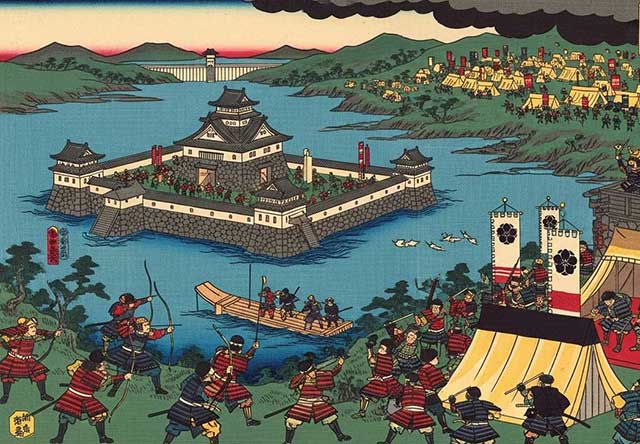
The siege of Takamatsu Castle in Bitchu Province is considered the first mizuzeme, or “water siege,” in Japanese history. Until then, such an original tactic had never been used.
The political situation before the siege
After defeating the Ikko-ikki stronghold of Ishiyama Honganji and completing his campaign in the provinces of Ise and Iga, Oda Nobunaga controlled most of central Japan by 1582. The capital Kyoto and the strategically important Tokaido and Nakasendo roads were under his control. It was time to deal with his enemies in the west, in the Chugoku region.
Two of Nobunaga's most experienced commanders had been conducting parallel campaigns for several years: Toyotomi Hideyoshi was advancing along the southern coast of the region, while Akechi Mitsuhide was operating in the north, along the Sea of Japan coast.
The start of the campaign in Bitchu Province
Hideyoshi's campaign against the Mori clan boiled down to a series of sieges. By the spring of 1582, he had advanced to Bitchu Province and laid siege to Takamatsu Castle with an army of about 30,000 men.
The castle was built in the second half of the 16th century by one of the generals of the Ishikawa clan. In 1575, the Mori clan captured the fortress along with the entire province of Bitchū. Shimizu Muneharu was appointed commander of Takamatsu.
The castle and its features
Takamatsu Castle was a type of hirajiro, a flatland castle built on flat terrain. It was surrounded by swamps, which provided excellent natural protection, especially effective against cavalry. The fortress did not have strong walls or moats and relied heavily on natural barriers.
At the time of the siege, the garrison numbered between three and five thousand men, according to various sources.
Unsuccessful attacks and the decision to flood
Hideyoshi attempted to take the castle immediately, but after two unsuccessful attacks, he was forced to retreat. He also attempted to persuade the commandant, Muneharu, to surrender by promising him possession of the province of Bitchu, but Muneharu refused.
Hideyoshi then decided to employ an unusual engineering solution, which, according to legend, was suggested by his strategist, Kuroda Kanbei. On his orders, soldiers and recruited peasants dug a canal from the Asimori River to the castle in twelve days. After that, the river, swollen from the rains, was dammed, and water poured into the valley where Takamatsu stood. Soon, the entire area around the fortress turned into a huge lake.
The rising water caused many inconveniences for the defenders—the castle was surrounded by water, and rats, snakes, and insects fleeing the flood penetrated inside.
To increase the pressure on the garrison, Hideyoshi ordered the construction of barges with towers from which the castle was constantly bombarded with arquebuses.
Help from the Mori clan and the threat of a counterattack
Shimizu Muneharu found himself in an extremely difficult situation and turned to his suzerain, Mori Terumoto, for help. Terumoto soon arrived with a large army, including troops from his relatives in the Kikkawa and Kobayakawa clans. Mori's forces were comparable to Hideyoshi's army.
Now it was Hideyoshi who, fearing encirclement, requested reinforcements from Oda Nobunaga.
Nobunaga's death and Akechi Mitsuhide's coup
Nobunaga saw the situation as an opportunity to destroy the Mori clan in one fell swoop and sent all available reserves under the command of six of his generals, including Akechi Mitsuhide, to help Hideyoshi. He himself was going to join the army soon, but on the way he stopped in Kyoto at the Honnoji temple.
On that day, Nobunaga had only 200 guards with him instead of the usual 2,000. Akechi Mitsuhide took advantage of this and decided to betray his lord. He raised a rebellion and attacked Nobunaga with an army of 13,000.
Nobunaga fought bravely, but after being wounded in the elbow and realizing that defeat was inevitable, he committed suicide in the burning temple. Soon after, in another part of Kyoto, his son and heir, Oda Nobutada, was killed in battle with Mitsuhide's troops.
Negotiations and the end of the siege
The further development of events was determined by chance. A messenger sent by Akechi Mitsuhide to Mori Terumoto with news of Nobunaga's death and a proposal for an alliance against Hideyoshi was accidentally intercepted by Hideyoshi's soldiers.
Learning of his suzerain's death before the enemy, Hideyoshi seized the moment and entered into negotiations with Terumoto. Peace was concluded on fairly lenient terms, but one of the points of the agreement was the demand that the commandant of Takamatsu commit suicide.
Shimizu Muneharu carried out the order—he committed seppuku on a floating platform in full view of both armies.
Consequences of the siege
After Muneharu's death, Hideyoshi lifted the siege and immediately advanced on Kyoto. There, he defeated the traitor Akechi Mitsuhide at the Battle of Yamazaki, ending the bloody chain of events that had begun at the walls of Takamatsu Castle.
See also
-
The Siege of Hara Castle

The Shimabara Rebellion of 1637–1638, which culminated in the siege of Hara Castle, was the last major uprising of the Edo period and had serious political consequences.
-
Battle of Tennoji
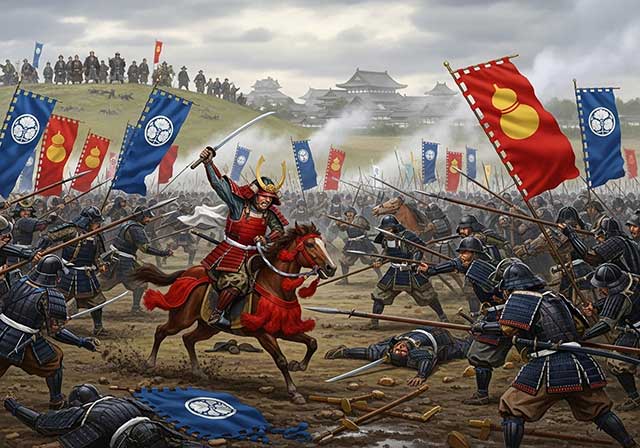
The confrontation between Tokugawa Ieyasu and Toyotomi Hideyori during the “Osaka Winter Campaign” ended with the signing of a peace treaty. On January 22, 1615, the day after the treaty was signed, Ieyasu pretended to disband his army. In reality, this meant that the Shimazu forces withdrew to the nearest port. On the same day, almost the entire Tokugawa army began filling in the outer moat.
-
Siege of Shuri Castle
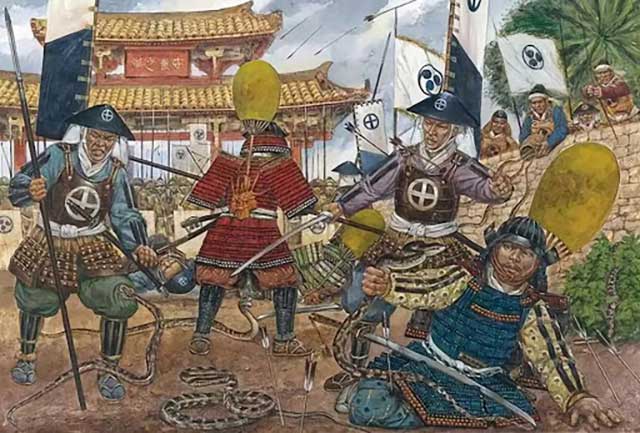
The Ryukyu Kingdom was established in 1429 on Okinawa, the largest island of the Ryukyu (Nansei) archipelago, as a result of the military unification of three rival kingdoms. In the following years, the state's control spread to all the islands of the archipelago.
-
The Siege of Fushimi Castle
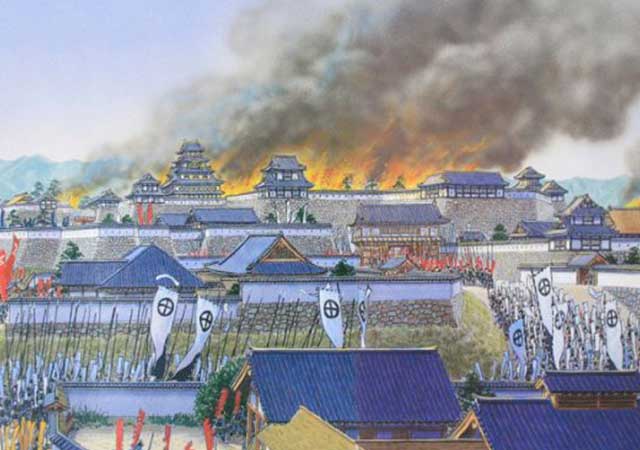
Fushimi can perhaps be considered one of the most “unfortunate” castles of the Sengoku Jidai period. The original castle was built by Toyotomi Hideyoshi in the southeast of Kyoto in 1594 as his residence in the imperial city.
-
The Siege of Otsu Castle
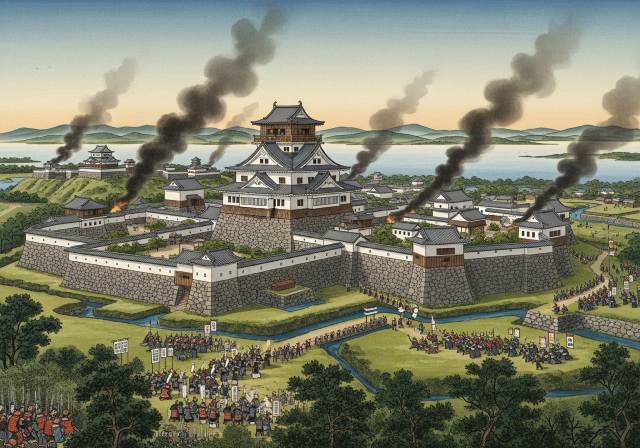
The siege of Otsu Castle was part of the Sekigahara campaign, during which the so-called Eastern Coalition, led by Tokugawa Ieyasu, fought against the Western Coalition, led by Ishida Mitsunari. Otsu Castle was built in 1586 by order of Toyotomi Hideyoshi near the capital Kyoto, on the site of the dismantled Sakamoto Castle. It belonged to the type of “water castles” — mizujō — as one side of it faced Japan's largest lake, Lake Biwa, and it was surrounded by a system of moats filled with lake water, which made the fortress resemble an island.
-
The Siege of Shiroishi Castle
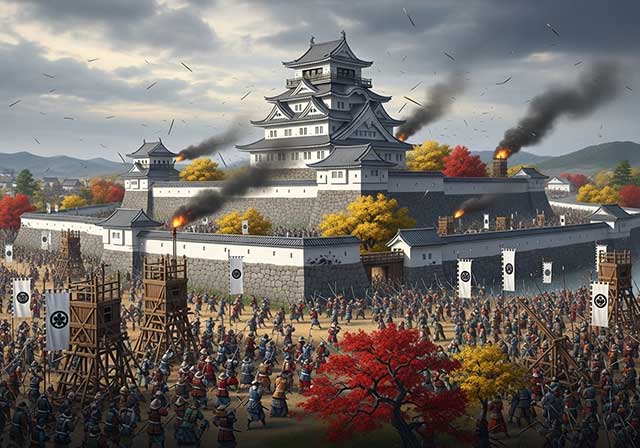
The siege of Shiroishi Castle was part of the Sekigahara campaign and took place several months before the decisive battle of Sekigahara. The daimyo of Aizu Province, Uesugi Kagekatsu, posed a serious threat to Tokugawa Ieyasu's plans to defeat the Western Coalition, and Ieyasu decided to curb his actions with the help of his northern vassals. To this end, he ordered Date Masamune to invade the province of Aizu and capture Shiroishi Castle.
-
The Second Siege of Jinju Castle
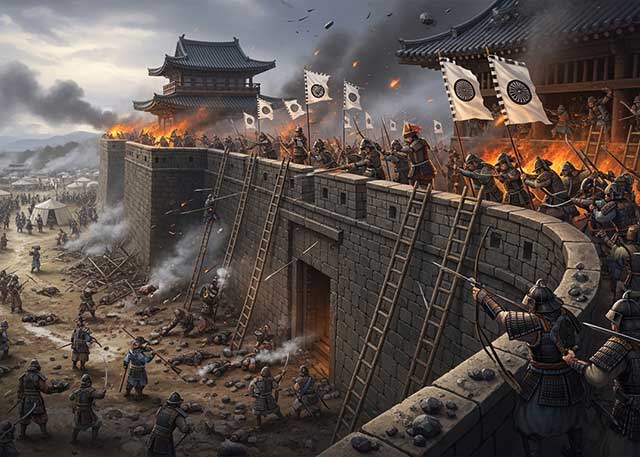
During the two Korean campaigns of the 16th century, the Japanese repeatedly had to capture enemy fortresses and defend occupied or constructed fortifications from the combined Korean and Chinese forces. Among all the operations of that time, the second siege of Jinju Castle is considered the most interesting from the point of view of siege warfare.
-
The Third Siege of Takatenjin Castle

The history of the castle prior to the conflict between the Tokugawa and Takeda clans is rather unclear. According to one version, the castle was built in 1416, when Imagawa Sadayoshi (1325–1420) was governor of Suruga Province and half of Totomi Province. Allegedly, it was he who ordered Imagawa Norimasa (1364–1433) to build this fortification. However, no reliable evidence has been found to support this. Another version is considered more plausible, according to which the castle was built during the conquest of Totomi Province at the end of the 15th century by Imagawa Ujitsuna (1473–1526) and his general Ise Shinkuro (Hojo Soon). In this case, another of Ujitsuna's generals, Kusima Masashige (1492–1521), is considered responsible for the construction.

